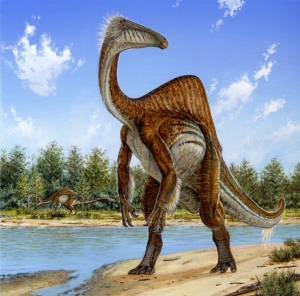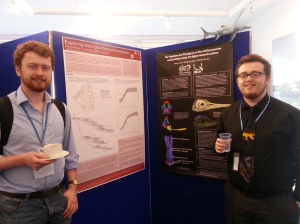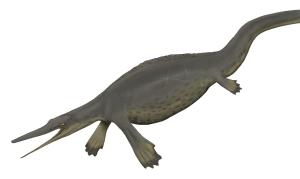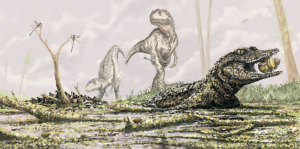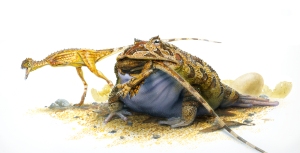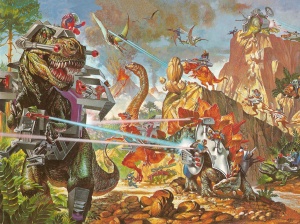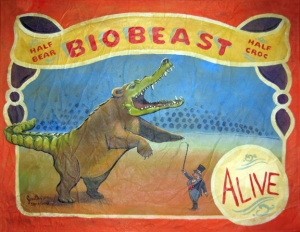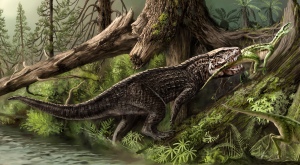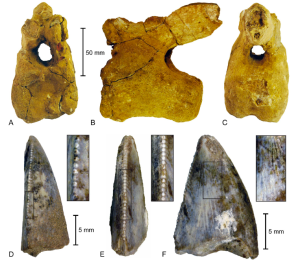Over the last 12 months or so, I’ve been researching ichthyosaurs for my masters project, and since then, I’ve been working on publishing my results. As such, I’ve learnt a fair bit of ichthyosaur palaeobiology and systematics. I’m no expert, but at this early stage in my academic career, I can say that at the moment, ichthyosaurs (specifically ichthyosaur endocranial anatomy) are my ‘specialisation(s)’, perhaps even making me an ichthyo-sir (heh). To this end, Motani et al.’s recent publication in Nature was massive news for ichthyosaur palaeobiologists. And that’s why it’s got its own little blog post.
What’s all the fuss about then? This year (2014) marked the anniversary of the 200 years since the first appearance of ichthyosaurs in scientific literature, and ichthyosaurs are closely associated with palaeontological celebrities, both historical (Mary Anning) and rather more recent (Alfred Romer). In those 200 years, we’ve learnt a lot about ichthyosaurs, and whilst they’re not ‘some kind of fish-lizard’, they are diapsid reptiles that were some of the first tetrapods to evolve a thunniform (fish/tuna-like) bodyplan, which aided them in their marine adventures. We know what colour some of them were thanks to melanosomes (Lindgren et al. 2014), we also know that they gave birth to live young, like mammals and some sharks do. We have exceptional fossils of ichthyosaurs actually giving birth, and others with amazing detailed and undisturbed soft tissue outlines. However despite all these amazing discoveries, we still don’t know a whole lot about two major aspects of ichthyosaur palaeobiology: their precise biomechanical function (we can’t create fancy 3D digital models due to the lack of 3D specimens, most ichthyosaur remains are mostly pancake-flat, even the really awesome ones) and perhaps more importantly, how they place in wider diapsid phylogeny.
Now before I go any further, it might be a good idea to explain what I mean by diapsid. Diapsida is a group of organisms (more specifically tetrapods) that have two temporal fenestrae (holes) in each side of their heads. Now this is a pretty large group, including archosaurs (dinosaurs, birds and crocs), lizards, snakes and tuataras. So whilst we have some vague idea where ichthyosaurs lie within this pretty large evolutionary tree, we’re not entirely sure. Why? Well because we don’t have transitionary fossils, ichthyosaurs previously (before Motani et al. 2014) appeared in the fossil record as highly adapted marine reptiles, well suited to the marine environment (remember, they look like fishes). So without any hint of which precise group of terrestrial organisms they evolved from, the topic of where ichthyosaurs came from is highly debated. So much in fact that in 2006, a very prominent ichthyosaur worker, Michael Maisch declared that the placement of ichthyosaurs within Diapsida was “…impossible…” (Maisch et al. 2006) without more basal specimens.
The internal phylogeny of ichthyosaurs isn’t a much better state either, with tree topologies changing at every opportunity of the last 10 years or so, threatening to change again when new systematic methods are applied. This again is largely due to the lack of well preserved three-dimensional specimens. But it’s not all doom and gloom, amazingly preserved specimens like those used in Lindgren et al. 2014 have shown us the colour of these ancient fish-dolphins (joke name, please don’t take it seriously), and Fischer et al. 2013’s discovery of Malawania has helped, to some degree, solve the internal phylogeny of at least neoichthyosaurs and ophthalmosaurs (ichthyosaurs from the Jurassic onwards). And obviously, my work on ichthyosaur endocranial and neuroanatomy from an exceptionally three-dimensionally preserved specimen will be hopefully well received (more on that in the coming months). So it’s not all doom and gloom. But still, ichthyosaurs aren’t exactly the Brangelina of the palaeontological scene, no sir, those celebrity couples occupying all the headlines are dinosaur discoveries such as Deinocheirus and Dreadnoughtus, and the number of ichthyosaur workers isn’t exactly huge.
To my shocked delight, on the afternoon of the 5th of November, 2014 I stumbled upon a fresh new ichthyosauriform, in a Nature paper. Good heavens! Could it be true? Well, of course, other wise I’d have spent the last hour typing madly about ichthyosaurs for no apparent reason. Catorhynchus lenticarpus (‘shortened snout’, ‘flexible wrist’) is a weird, small beast. At first glance, you’d be forgiven for thinking that Catorhynchus wasn’t even a ichthyosaur at all. Well, technically, it isn’t an ichthyosaur at all, it’s an ichthyosauriform. Catorhynchus comes from the Lower Triassic, approximately 248 million years-ago, and whilst some would call it an ‘ichthyosaur’, the Ichthyosauria (essentially all of the things your properly allowed to call ‘ichthyosaurs’) didn’t occur until later on in the Triassic. So, what the hell is Catorhynchus? Simple, it’s an ichthyosauriform, an ichthyosaur-looking creature which is more closely related to Ichthyosaurus communis than to a hupesuchian? Wait, what the hell are hupehsuchians, and what do they have to do with anything?
Good question. Hupehsuchians are a weird bunch of marine reptiles, who you’d be very much forgiven for calling ichthyosaurs, because well, they look quite a lot like ichthyosaurs. This simple fact has led many researchers to state that ichthyopterygians and hupehsuchians were related, however, there’s been little evidence to really cement this (just because two organisms look the same/have similar features, doesn’t mean they’re closely related. For example birds and bats both have wings, but they evolved powered flight independently and convergent to each other). As I’ve previously said, this is due to the lack of really primitive fossil ‘ichthyosaurs’ as well as our fairly poor understanding of where ichthyosaurs fit relative to other diapsids. However, Catorhynchus has given us a glimmer of hope, enabling us to, for the first time, really start to understand how ichthyosaurs first came about. Now, thanks to Catorhynchus, we think that ichthyosauromorphs (which now includes hupehsuchians) originated in China in the Earliest Triassic, which was a warm tropical archipelago ‘back in the day’. This is interesting, as we know that other groups of marine reptiles, such as sauropterygians (plesiosaurs, pliosaurs et al.) may have also originated in this area at the same time, so Earliest Triassic China may have provided very good conditions to harbour the evolution of many marine reptiles.
Don’t worry, I’ll stop teasing you now, I’ll actually talk about the fossil for a bit. With a host of unusual features such as really short snout, large flippers and a short body length (the shortest of all ichthyosauromorphs, estimated at a tiny 40 cm) and a really deep lower jaw, Catorhynchus is a weird beast. Yet, despite all these abnormalities, it looks like an ichthyosaur, I mean look at those big eyes! However, it also looks like a juvenile ichthyosaur. For me, and other ichthyosaur workers I’ve spoken to, this is the main reason why people of sceptical about drawing so many big conclusions from Catorhynchus. However, other people (untrustworthy creator of reptileevolution.com) have said that it certainly can’t be an ichthyosaur, and has to be an ‘ichthyosaur-mimic’, because yeah, if it has loads of scientifically diagnostic features of an ichthyosaur the most obvious answer is that it wants you to think it’s an ichthyosaur, just to troll the scientific community, and then years later scream ‘psyche!’ to everyone, you know, because fossils love to mess with us, the jerks.
ANYWAY. I think it’s worth pointing out that it realistically might turn out to be a juvenile, even though Motani et al. do present some evidence that it’s a fully grown adult, for example the forefins of Catorhynchus are almost as long as its skull, a feature found exclusively in adult individuals. However, it’s also worth mentioning that even despite this, Motani et al. don’t completely dismiss the possibility of this specimen being a juvenile. Essentially, I feel it’s best to take this discovery with a pinch of salt until we find a few more specimens of Catorhynchus. Despite this uncertainty, we can be fairly sure that Catorhynchus may have been amphibious. Yeah, that’s right, amphibious and NOT an amphibian. Other articles have said that Catorhynchus is an amphibian, this is incorrect, as Amphibia form their only little group of organisms, which ichthyosauromorphs aren’t part of! However, Catorhynchus is amphibious, i.e. it shares its time between land and water. How do we know this? Well from the fossil, Motani observed that the carpus may have allowed the flipper to bend in a way much like the flippers can bend in seals, and since seals have flippers for limited terrestrial locomotion, it seems likely that this was also the case for the flippers of Catorhynchus. Motani also presents a case for suction feeding in Catorhynchus, which brings the contentious debate of whether other ichthyosaurs fed via suction feeding back to the table.
To summarise Motani and friends have presented the world with a new ichthyosauromorph which, if verified with further specimens, will help us to really start to understand how ichthyosaurs (and perhaps marine reptiles more widely) first evolved, as well as to understand the place of ichthyosauromorphs within Diapsida. And since it was published in Nature, it might turn a few heads, perhaps persuading more people to join the very small field of ichthyosaur of palaeobiology. As always let us know what you think, comment below or Tweet us (or indeed, even Facebook us).








